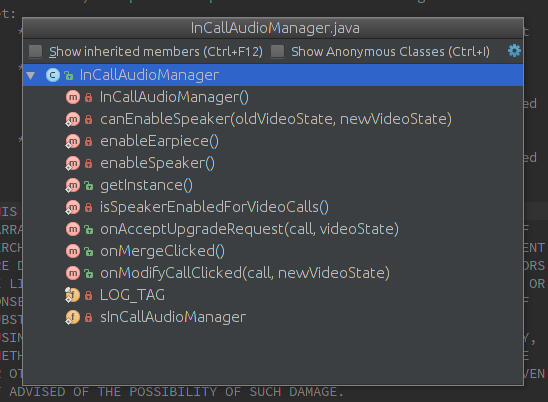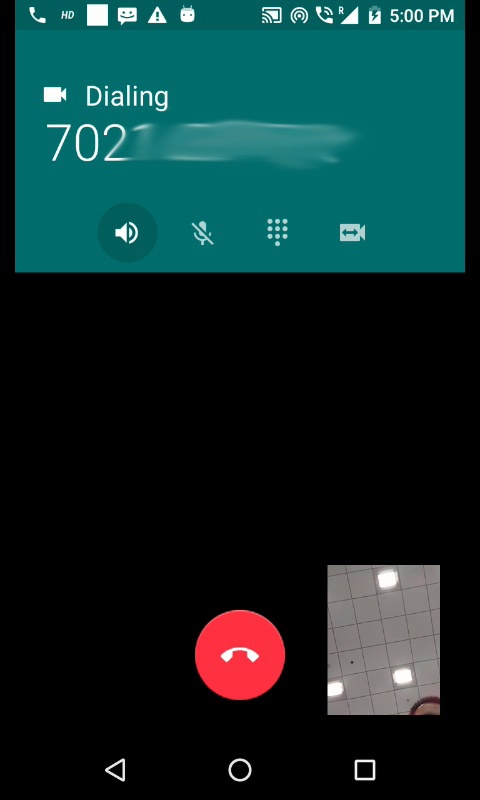Audio in Video Call(Android_M)
相关:
- InCallScreen中CallButton界面更新介绍(audioButton等)
- Android L上VideoCall中Audio的管理
- Android M上VideoCall中Audio的管理
- CallAudioManager是如何工作的
在前一篇中我简单介绍了在Android L 版本中Video Call中audio切换的一些信息,本篇以QCOM Release的Android M版本为基础看一下6.0上的Video Call中的audio相关变化。
文件变化
比较明显的变化是 M上InCallUI中新增了一个类InCallAudioManager.java,见名知意,这是一个专门管理通话中Audio状态的类。 先看一下这个类里有那些方法:
 图1: 文件结构
从方法名上可以大致看出这是一个管理call在 upgrade、modify和merge时候去开启扬声器或听筒的类。
先声明一点,enableSpeaekr()和enableEarpiece()两个方法不是被调用了就一定会产生AudioMode的变化,具体的判断条件我们放到最后再讲。
图1: 文件结构
从方法名上可以大致看出这是一个管理call在 upgrade、modify和merge时候去开启扬声器或听筒的类。
先声明一点,enableSpeaekr()和enableEarpiece()两个方法不是被调用了就一定会产生AudioMode的变化,具体的判断条件我们放到最后再讲。
我们先看一下两个方法的调用层级:
enableSpeaker() 的调用层级
 图2: enableSpeaker()方法调用层级
上面这张图可解释为3个打开Speaker的场景:
图2: enableSpeaker()方法调用层级
上面这张图可解释为3个打开Speaker的场景:
- 当点击合并通话时;
- 当接受升级为视频电话是;
- 当更改通话类型时。
其中第1种:当合并的两路通话中有一路是视频电话时打开Speaker:
/**
* Called when user clicks on merge calls from the UI. Route audio to speaker if one of the
* calls being merged is a video call.
*/
public void onMergeClicked() {
Log.v(this, "onMergeClicked");
if (CallUtils.isVideoCall(CallList.getInstance().getBackgroundCall()) ||
CallUtils.isVideoCall(CallList.getInstance().getActiveCall())) {
enableSpeaker();
}
}
ModifyCall有两种情况,我们放到下面跟enableEarpiece一起说。
enableEarpiece()的调用层级
 图3: enableEarpiece()方法调用层级
可以看到打开听筒的唯一调用地方是ModifyCall,ModifyCallClicked()方法代码如下:
图3: enableEarpiece()方法调用层级
可以看到打开听筒的唯一调用地方是ModifyCall,ModifyCallClicked()方法代码如下:
/**
* Called when user sends an upgrade/downgrade request. Route audio to speaker if the user
* sends an upgrade request to Video (bidirectional, transmit or receive) otherwise route
* audio to earpiece if it's a downgrade request.
*/
public void onModifyCallClicked(final Call call,final int newVideoState) {
Log.v(this, "onModifyCallClicked: Call = " + call + "new video state = " +
newVideoState);
if (!VideoProfile.isVideo(newVideoState)) {
enableEarpiece();
} else if (canEnableSpeaker(call.getVideoState(),newVideoState)) {
enableSpeaker();
}
}
可解释为:升级为视频电话时打开Speaker,降级时打开Earpiece。
实际AudioMode是否变换?
前面我们说过及时调用了这两个方法也不会一定产生AudioMode的变化,enableSpeaker()方法前的注释里已经写得很清楚了。 当现在蓝牙和有线耳机没有连接,且当前audio不是通过Speaker传送的话,打开Speaker。听筒同理。 (我觉得QtiCallUtils.isEnabled()方法有点意思,可以打开看看)
/**
* Routes the call to the speaker if audio is not being already routed to Speaker and if
* bluetooth or wired headset is not connected.
*/
private static void enableSpeaker() {
final TelecomAdapter telecomAdapter = TelecomAdapter.getInstance();
if (telecomAdapter == null) {
Log.e(LOG_TAG, "enableSpeaker: TelecomAdapter is null");
return;
}
final int currentAudioMode = AudioModeProvider.getInstance().getAudioMode();
Log.v(LOG_TAG, "enableSpeaker: Current audio mode is - " + currentAudioMode);
if(!QtiCallUtils.isEnabled(CallAudioState.ROUTE_SPEAKER |
CallAudioState.ROUTE_BLUETOOTH | CallAudioState.ROUTE_WIRED_HEADSET,
currentAudioMode)) {
Log.v(LOG_TAG, "enableSpeaker: Set audio route to speaker");
telecomAdapter.setAudioRoute(CallAudioState.ROUTE_SPEAKER);
}
}
补充
到这就完了么?上面我们从代码中推出了一些场景以及实现,那么在实际使用中以现有的代码能满足用户需要么? 这个问题先留在这,等后面如果项目上有报相关的bug的时候我再来更新。
- 视频电话降级为语音电话关闭Speaker 这个我在前一篇博客中写到过,不过依现在M上的代码来看,只有发起降级的一端会关闭Speaker,接收端的AudioMode貌似不会更改。不过这种现象也可以理解,对方没有准备的情况下,扬声器突然关掉了的话,而假如用户又没有意识到的话,会听不到通话另一方的声音的。
2016.05.27 更新
看图
 上图中可以看出,在正在拨号的界面Speaker的状态就已经是打开的了,而从上面的分析中却没有代码执行对应的动作,那么这个Speaker是在什么地方打开的呢?
CallsManager.java
上图中可以看出,在正在拨号的界面Speaker的状态就已经是打开的了,而从上面的分析中却没有代码执行对应的动作,那么这个Speaker是在什么地方打开的呢?
CallsManager.java
/**
* Checks to see if the call should be on speakerphone and if so, set it.
*/
private void maybeMoveToSpeakerPhone(Call call) {
if (call.getStartWithSpeakerphoneOn()) {
setAudioRoute(CallAudioState.ROUTE_SPEAKER);//打开Speaker
call.setStartWithSpeakerphoneOn(false);
}
}
private void maybeMoveToEarpiece(Call call) {
if (!call.getStartWithSpeakerphoneOn() && !mWiredHeadsetManager.isPluggedIn() &&
!mCallAudioManager.isBluetoothDeviceAvailable()) {
setAudioRoute(CallAudioState.ROUTE_EARPIECE);//打开听筒
}
}
调用层级:
 上面的代码解释了,在拨号界面Speaer就打开的原因。
在CallsManager.java中新增了多个方法,上面只是其中一部分,实现的功能也是控制Speaker和Earpiece的开关,里面用的值是在哪里设置的呢?
上面的代码解释了,在拨号界面Speaer就打开的原因。
在CallsManager.java中新增了多个方法,上面只是其中一部分,实现的功能也是控制Speaker和Earpiece的开关,里面用的值是在哪里设置的呢?
/**
* Attempts to issue/connect the specified call.
*
* @param handle Handle to connect the call with.
* @param gatewayInfo Optional gateway information that can be used to route the call to the
* actual dialed handle via a gateway provider. May be null.
* @param speakerphoneOn Whether or not to turn the speakerphone on once the call connects.
* @param videoState The desired video state for the outgoing call.
*/
void placeOutgoingCall(Call call, Uri handle, GatewayInfo gatewayInfo, boolean speakerphoneOn,
int videoState) {
//...
// Auto-enable speakerphone if the originating intent specified to do so, or if the call
// is a video call or if the phone is docked.
call.setStartWithSpeakerphoneOn(speakerphoneOn || isSpeakerphoneAutoEnabled(videoState)
|| mDockManager.isDocked());
call.setVideoState(videoState);
//...
}
可以看到在placeOutgoingCall()中增加的这段代码自动打开了speakerphone 。
总结
回顾以前的代码,加上今天更新的内容,可以得到一个信息:在Android M上,通话中AudioRoute的控制,在InCallUI部分全新改写,跟enterVideoMode()和exitVideoMode()两个方法没有直接关系。同时不止存在于InCallUI层,Telecomm的CallsManager也牵扯进来了。